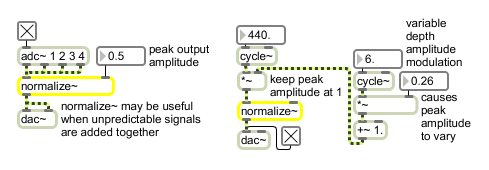Examples

When precise scaling factor varies or is unknown normalize~ sets peak amplitude
Scale on the basis of maximum amplitude
| Name | Type | Opt | Description |
|---|---|---|---|
| initial-maximum-output-amplitude | float | opt | The initial maximum output amplitude. The default is 1. |
| int | maximum-output-amplitude [int] |
Converted to . |
| float | maximum-output-amplitude [float] |
In right inlet: The maximum output amplitude may be sent as a instead of a . If a signal is connected to the right inlet, a received in the right inlet is ignored. |
| reset | maximum-input-amplitude [float] |
In left inlet: The word , followed by a number, resets the maximum input amplitude to the number. If no number follows , or if the number is 0, the maximum input amplitude is set to 0.000001. |
| signal | In left inlet: The input signal is normalized -- scaled so that its peak amplitude is equal to a specified maximum. In right inlet: The maximum output amplitude; an over-all scaling of the output. |

| Name | Description |
|---|---|
| *~ | Multiply two signals |
| MSP Tutorial 28: Delay Lines with Feedback | MSP Tutorial 28: Delay Lines with Feedback |